Day 9
May 12, 2003
(Monday)
Kusadasi, Turkey
A coupla corrections for Day 8's report: Greece was under Turkish rule for 400
(not 200) years, and the Greek peninsula is spelled "Peloponnesian," which happily
doesn't make it any less fun to say!
6:35 am
We pull into glamorous Kusadasi, Turkey and the excitement level is high! "Kusadasi!
Wow!" says Robert, "Why the hell are we in Kusadasi?"
Well, aside from being conveniently opposite Athens, Kusadasi is also the port
for Ephesus.
"Oh, well now it makes sense," exclaims Robert, "so why the hell do we care about
Ephesus?"
Ephesus turns out to be important to the early Christian church. Not only did
Paul write letters to them (as in "Paul's letter to the Ephesians") but St. John
the Evangelist is buried here, and tradition has it that Jesus' mother lived in
a house here for a while.
But it's not so important that we'll be here for a whole day, as the ship is taking
off about 1:00 pm.
The seas have been calm ever since the gale force winds, and that continues here.
We hope that Neptune has given up trying to sink the boat.

The Port of Kusadasi, as seen from our balcony
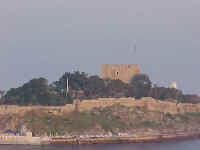
A Kusadasi fort
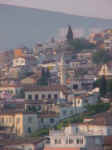
Kusadasi in the morning
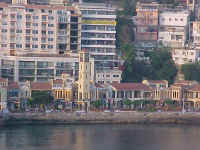
Downtown Kusadasi
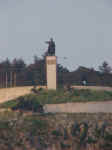
Statue of Ataturk
7:30 pm
On yet another tour bus, this time our guide is Mahmut. We like to sit in the
back of the bus, partly from force of habit, but also because we can grab the
entire back row and peer out whatever side of the bus is more interesting. Also,
we can have spitball fights and not get caught.
Turkey got modern in a hurry in the 1920's after World War I. A guy came in and
got everybody organized and straightened out. Originally, he had a name of his
own, but it occurred to the people that if they let him keep his name, they'd
have to rename the country (because they thought he was pretty darn cool).
Instead of calling the country Basarmaliyazland, they decided it would be easier
to change his name to Ataturk (which means "Father of the Turks"), so then
they could keep the country's name the same.
Ataturk actually did a fairly remarkable thingóhe created pretty much the only
secular Islamic state in the Middle East. Although many people are Moslem, prayers
are not required, and shops can be open on Fridays, and the government gets things
done. Consider that Turkey is bordered by Syria, Iran, and Iraq and you begin
to understand how hard that had to be.
We should also mention that until last week, the State Department had a Travel
Advisory for American citizens advising that they avoid Turkey. (The boat had
changed its schedule until the advisory got pulled on May 1.)
[Frankly, we think this was a cheesy attempt by the US Government to punish the
Turkish people for not letting us invade Iraq through their country. The Turks
are fabulously gracious and we felt safer than we do in Seattle.]
Good old Ataturk also had everybody switch from Arabic (which takes school kids
about three years to learn) to a modified Latin alphabet (you know, a, b, c, etc.)
which only takes a couple of months to learn.
So, here's your first Turkish lesson (also our first Turkish lesson):
Yes = Ever
No = Hayir
Please = Lutfen
Thank You = forget it, it's about a yard long and impossible to say; try "Thank
you"
Mahmut also explains that "Kusadasi" means "Pigeon Islands" because they have
more of those than they know what to do with. About 50,000 people live in Kusadasi
year round, but this number swells to about 500,000 during the summer.
Mahmut says they are happy to see Americans and British back, because they haven't
had many visitors since 9-11. (Actually, "happy" is an understatement; "ecstatic"
might be closer to the truth.)
Turkey itself is bigger than Washington and Oregon combined, and has about 50
million people.
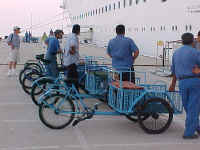
Kusadasi taxis
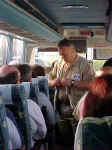
Mr. Guide Guy (Mahmut)
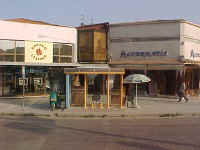
Downtown Kusadasi
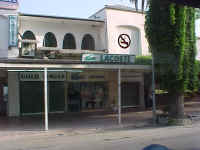
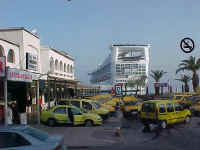
The amazing "No Smoking" symbol that mysteriously appears only in these two
pictures; we suspect space aliens....
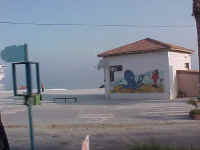
Small beach house with mural of an octopus getting ready to eat tourists
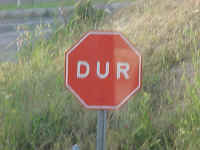
Turkish stop sign
8:00 am
St. John's Basilica
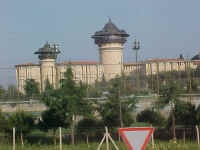
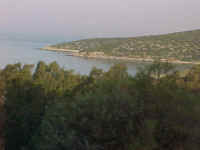
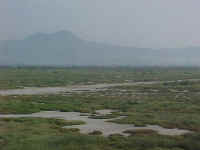
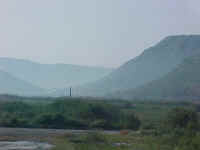
Scenery on the way to St. John's Basilica
We arrive at one of the very first Christian churches, which is also where St.
John is buried (hence the name). It's mostly ruined now, but even the ruins are
pretty impressive.
As in Rome, the baptistry is separate and looks pretty cool. It's in the shape
of a cross, with stairs leading down into the deepest part and another set of
stairs leading up out of the water. "In baptism you are buried with Christ then
raised up as he was."
While we're there, some Turkish vendors offer to sell us "old Roman coins, genuine!"
We pass. We figure either they're fake ("Look! Date is 15 BC!") and a waste of
money, or they're real in which case we're encouraging archaeological theft. (You
go on one lousy dig, and you get these extreme attitudes that show up years later...)
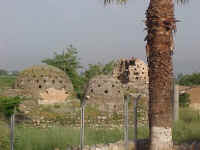
Baths near St. John's
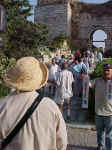
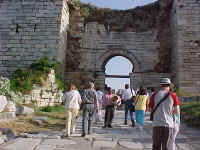
Laura at the ruins of St. John's Basilica
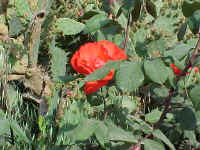
Some flower or another, probably a cactus
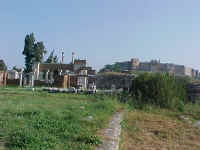
St John's Basilica
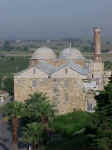
A nearby building of some kind or anotherólooks cool at any rate

View from St. John's of the surrounding countryside
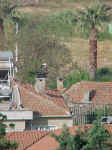
Stork on a chimney (which brings good luck, according to local Christian legend)
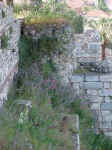
Flowers growing at St. John's (you can always spot the pictures that Laura takes...)
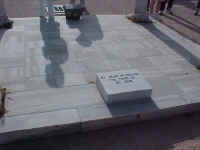
The actual spot where they planted St. John
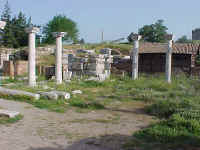
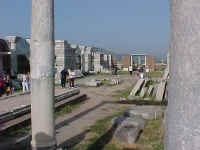
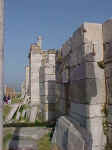
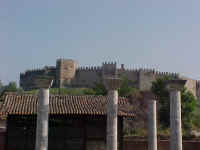
Views of various parts of the ruins of St. John's Basilica
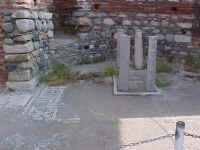
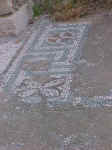
More early Roman mosaic work
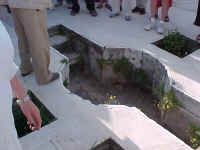
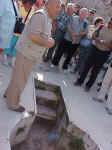
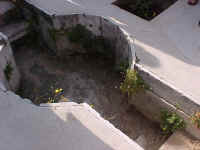
The Baptistry (Mahmut in the center explains how it works). Note the steps
leading in. Also note the severe case of bathtub ring.
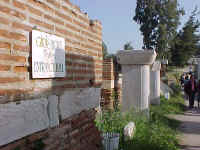
The Narthex, as seen from the Fellowship Hall
8:30 am
We're approaching Mary's house on the island. The deal is that Jesus commanded
St. John to look after his Mom, and to St. John this apparently meant hauling
her all over the known world as he evangelized the people. Because there is good
evidence that St. John traveled to Ephesus, it was assumed that Mary was with
him.
When St. John blew into Ephesus, Mary was 62 years old and she stayed here for
six to eight years. At this time, Rome was none too fond of Christians, so they
tended to sneak around a lot. If they got caught, they would star in the matinee
show of Lions vs. Christians, which was a local favorite, despite the fact that
the show always had the same ending.
If you were a bishop or a priest, though, they usually just made you go live on
a Greek island. Apparently, they were worried that killing a priest or a bishop
would lay a serious hex on them (this made it much easier to find candidates for
the priesthood back then).
So, when Mary was here, they built her a small house way and the heck up in the
hills so the Romans wouldn't find her. Our opinion, after sitting on the bus climbing
a couple of thousand feet is that even if the Romans knew exactly where she was,
they would have thought it was too much trouble to climb the hill and get her.
And anyway, this location was based only on the sickbed vision of a Bohemian woman.
After the local authorities caught up with St. John and killed him (only one apostle
died of old age--being an apostle was a hazardous occupation), Mary went back
to Palestine and probably died there (nobody seems too sure).
Today, her house is a small chapel, attended to by Roman Catholic nuns. It's a
very quiet, peaceful place.
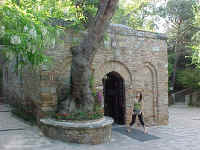
Apparently, there aren't any bathrooms in Mary's house...
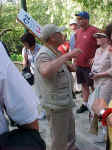
Mahmut explains about Mary's house
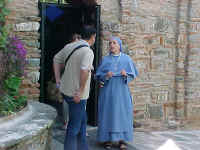
One of the nun's looking after the place (on the right)
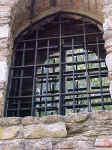
The bars at Mary's house are shaped like crosses
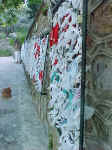
The Wishing Wall--write your prayer on a piece of toilet paper, put it on the
wall, and the next time it rains, you'll have a sodden prayer
This is in sharp contrast to the area outside, which is packed with vendors ("Post
card! One dollah!") and even a guy who will let you take a picture of his camel
for a dollar.
We discover the value of the Turkish lira when Robert buys a Turkish coffee (not
a Greek Coffee). The price board says that it is 1.5 million lira, which seems
a bit excessive to Robert ("Okay, a million lira I could see, but one and a half
million?").
Since we don't have any lira, Robert asks the waiter what the price is in Euros.
This requires a consultation between the barista, the waiter, and some third
person (who may have just been walking by). They come to the conclusion that (this
morning, anyway), it's about one Euro.
"Woo hoo!" says Robert, "I'm a millionaire! In fact, I'm a billionaire!!"
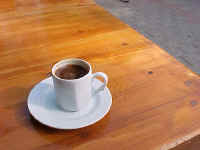
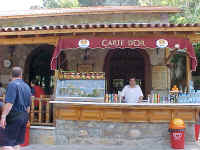
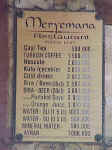
Turkish coffee (left) from the Turkish Coffee Joint (center) costs one and
one-half million according to the menu (right)
Seems that the Turkish lira is not in such great shape. (Mahmut later jokes that
when we started out this morning it was 1.5 million lira to the dollar, but now
he has no idea what it's worth because it's 11:30.)
A Turkish coffee is clearly distinct from a Greek coffee, because the cup is slightly
narrower and taller.
Laura finds some tiny versions of Turkish carpets for $1 each (for her dollhouse).
She says, "These go for $20 each or more at miniature shows" and Robert wants
to buy a few gross so we can pay for the trip.
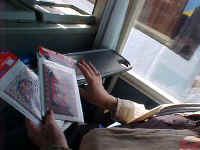
Laura admires her Turkish carpets
9:30 am
We reach the ruins of Ephesus. During the early days (up to the sixth century
AD), Ephesus was an important port city with lots of ships coming in and out.
But the river, Meander, silted up the harbor (like at Pisa). This meant that for
a while, it was marsh, and mosquitoes moved in.
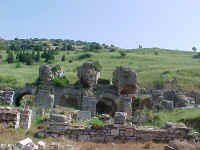
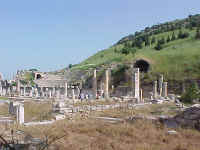
The entrance to the ruins of Ephesus
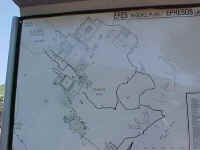
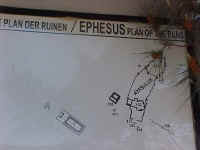
The "Plan of Ruins" for Ephesus (Robert thought it was funny that there was
a plan for the ruins--he always thought they just happened)
The mosquitoes carried disease and kind of wiped out most of the local population.
Between everybody being dead, and no longer having a harbor, business was bad
in Ephesus and it gradually fell into ruins.
The upside of this is that the ruins are still there. In lots of places in Europe,
ruins were scavenged for materials to build new buildings. (The Coliseum in Rome
looks so wrecked because the Italians kept using it for spare parts to build new
buildings.)
But in Ephesus they just got overgrown. They started excavating the area in 1889
and so far have uncovered about 10% of it. During the summer months, they close
down most of the tourist area and let the archaeologists have at it. (We felt
kinda sorry for the archaeology grad students digging during the hottest months
of the year. It's always grad students doing the grunt work.)
The result is that if we come back in 10 years, we'll see brand new stuff ("brand
new" meaning "newly rediscovered 2000-year-old things"). So this strategy turns
out to be a useful tourist gimmick, too.
During the first and second centuries (AD), the population of Ephesus reached
as much as 300,000 people (maybe more, it kinda depends on how many slaves there
were).
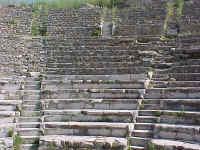
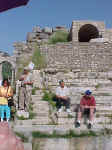
Near the entrance to the ruins
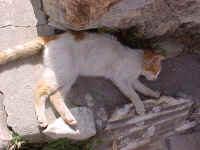
Turkish cats seem very similar to Greek cats (and American cats, for that matter)
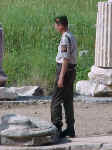
No one's going to steal any ruins while this guy's on the job!
When visitors entered Ephesus, they first had to pass through inspection (customs)
at the gate. Then they had to go take a bath and get clean, with the idea being
to cut down on the number of infectious diseases. Two thousand years later, we've
streamlined the process, and just ask people if they've been to Toronto.

Hillside near the entrance (where the poor folks lived)
The lower areas of the city were where the rich people lived. Not only did they
not have to climb around so much, but this also meant they had running water.
The Romans, just like in Pompeii, had figured out the whole gravity feed thing
and ran pipes down to the rich folks' houses.
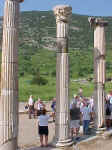
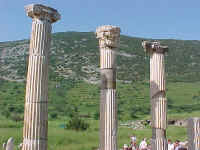
More ruins of Ephesus
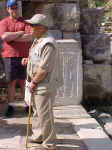
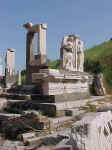
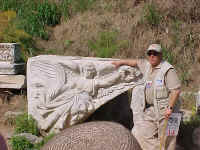
Mahmut explains about the first hospital--which looks a little run down, frankly
We also see one
of the very first hospitals. According to Mahmut, they had a clever admission
scheme. Two doctors would examine you, and if they thought you were going to die,
they wouldn't let you in. This dramatically raised their recovery rate, enhanced
their reputation, and two thousand years later, we call them HMOs.
They would also sneak into the patient's room while they were asleep and hold
a couple of snakes in their faces to wake them up. This tended to boost the recovery
rate, too ("Aargh! I feel much better! In fact, I'm ready to go home! So
long!!!").
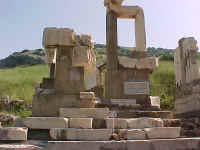
This is the tomb of Memmius, grandson of Sulla (1st century BC); Sulla was
apparently some local hot shot
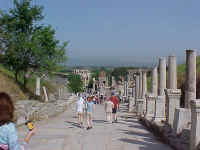
Gotta admire those nice straight Roman roads
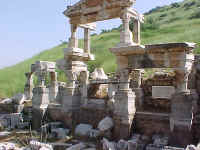
The Fountain of Trajan, dedicated by Aristion around 110 AD
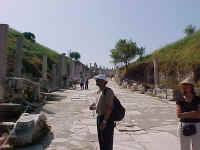
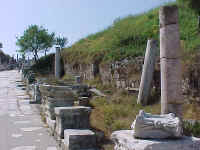
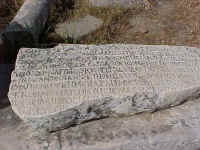
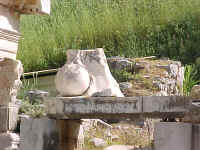
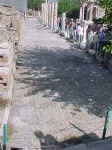
More ruins of Ephesus (which certainly has no shortage of ruins)
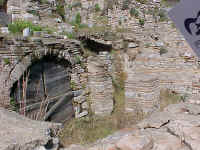
Entrance to a rich guy's house
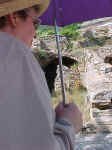
Laura stays cool in the sun
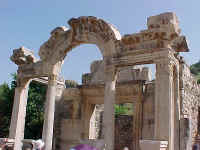

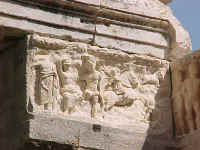
The Temple to Hadrian, which (we think) is the same Hadrian who motivated
Greek butts in Athens
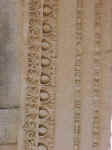
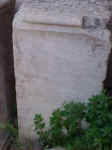
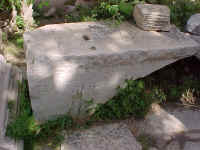
More ruins
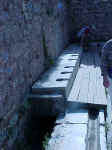
The communal toilets, where the hoity toity would go potty
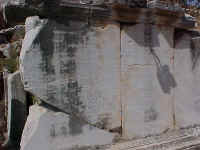
A wall with some Roman writing on it
10:16 am
We reach the library (or what's left of it). This was one of the larger libraries
in the Mediterranean and was packed with scrolls.
This library had an added feature that boosted its popularity. Seems that not
only was it across the street from the brothel, but there was also a tunnel running
from the library to the tunnel. Thus, you could walk in the front door of the
tunnel, visit the "stacks," and then walk back out the front door.
Mahmut says that just last year, they found a note from a guy that says, "My wife
says it's okay for me to visit the library." And of course, the wives would NEVER
have figured that one out. (Picture a group of guys saying "We're going down to
the library, hon" and elbowing each other in the ribs. "Yeah, we'll be READING
<snicker> <snicker>." We estimate the wives knew what was going on while they
were still drawing up the floor plan for the buildings.
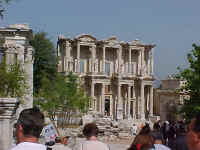
The library
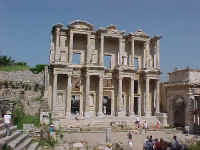
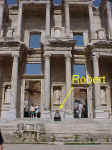
Robert feeling small and insignificant at the library
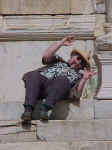
Robert melts in the hot sun on the steps to the library
10:32 am
We arrive at the local amphitheater, which holds up to 25,000 people. It was the
largest theater in Asia Minor at the time. The theater is extra renown for a speech
that Paul gave.
Seems that when Paul visited, the business people got nervous. They had a nice
little trade going in selling silver offerings to Artemis. Whenever somebody blew
into town, they bought an offering, took it to the temple and turned it over to
the priests. This was good for the silversmiths and the priests.
Along comes Paul who starts preaching about a God that doesn't ask for donations.
Naturally, merchants and priests get a little pissed.
But then he cast out a demon from a lady when a local priest couldn't. "Oh ho!"
they said, "Maybe there's something to what nutty Paul is saying after all!"
So about 25,000 of them gather in the amphitheater to hear Paul's talk. Apparently,
Paul hadn't heard of telling a joke to loosen up the crowd. He started out with
"Your gods are manmade and are a bunch of hooey."
The crowd went wild, but the wrong kind of wild, and Paul had 25,000 people demanding
to examine his entrails. The local cops hustled him off to jail. (For the whole
story, go to your handy New Testament and read Acts of the Apostles chapter
19.)
After six months, though, they let him go. Mostly because he kept showing up outside
the jail doing various religious things. He'd be securely locked in his cell one
minute, and the next minute he'd be doing baptisms down at the Meander river.
They "suggested" that he take his show on the road to someplace else.
Most recently, the theater was used for music concerts by modern acts (such as
Ray Charles). But during a Sting concert a couple of years ago, part of the theater
collapsed (who knew Sting could bring down the house?). Consequently, they only
allow classical music concerts, now (and probably not the 1812 Overture).
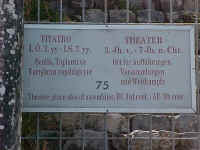

343° View from the stage at the Theater
10:45 am
We're back at the exit and again besieged by vendors. We like the guy who stands
in front of a sign that says "Genuine Fake Watches" and also hollers "Genuine
Fake Watches!" We wonder if some English translator has a nasty sense of humor.
One thing we notice about the vendors is that they're vocal and come right up
to you, but if you say "No, thank you" or shake your head, they back off. So,
some guy will come up and holler, "Come see my shop mister! Good stuff! Very cheap!"
but you just say "No" and he's gone, hustling somebody else.
Travel tip
To simplify things, the vendors quote the same price in dollars and
euros. So, a 5 euro souvenir is also a $5 souvenir (or about 10,000,000 Turkish
lira). Since 5 euros is actually about 6 dollars, you're better off paying in
dollars (it's cheaper).
Silly us--we'd been careful to make sure we carried Euros.....
11:00 am
We're grateful to be back on the bus, out of the hot (hot!) sun. The temperature
is inching towards the 90s and it's also really humid.
On the way back to Kusadasi, we get the industrial rundown from Mahmut.
There are three main products in Kusadasi: carpets, jewelry, and leather products.
Kusadasi is a very cheap place (despite being filled with Turkish millionaires).
You can buy a luxury house for $22,000 (with a lovely view of the Mediterranean)
and stay in a four star hotel for $12 a night.
Mahmut is a history teacher during most of the year, and he makes the princely
sum of $800 a month. Robert is ready to move here....
11:30 am
The Carpet Demonstration
We thought this would be some boring demonstration of how to make carpets. Instead,
we go to a carpet shop and proceed to a nice, cool area underneath. There, "Ali
Baba and his 40 Teas" appear (a lovely apple tea, very tasty) and the carpet merchant
presents his wares while explaining about carpets.
The presentation is pretty darn cool. One of his assistants picks up a rolled carpet and
throws it out so it hits the floor with a boom and seems to unroll itself.
And what unrolls is not some cheesy bathmat, but fine carpets with up to 450 knots
per inch. They've got cotton/wool blends (the cheapest), wool/wool (next up) and
pure silk (yowza!) rugs. The really nice ones change color depending on which
angle you view them from. Some of them are huge 15 feet by 8 feet rugs. Others
are the size of welcome mats. Some have intricate floral designs, while others
have geometrical patterns--some traditional, some modern.
By the end of the presentation, there's a three-foot deep pile of rugs on the
floor.
Prices? Well, good news and bad news. The good news is they're cheap, cheap, cheap.
You can get a find beautiful carpet that took 10 months to make and is about three
feet by five feet for $700 (shipped to your door in the US; $540 if you take it
with you).
The bad news? Well, figure out the hourly wage for a $700 carpet that takes 10
months to make. Even though they're made by young girls who go to school in the
morning and work on the carpets in the afternoon, it works out to about $1 an
hour.
Travel Tip
Don't take Robert with you if you want to buy something. He figures out
numbers like this in his head and makes you feel like you're supporting some
Third World sweatshop if you buy anything.
We would have bought a rug, but we have two cats, and the first time that one
of them threw up on the rug, we'd have to kill them. We decided we could avoid
a lot of trouble and stress by not getting a really nice Turkish carpet.
We wander around the bazaar for a while ("Come see my shop, mister!" "Very fine
leather jackets here!" "Jewelry! Jewelry!" "Very cheap! Very good!") and then
head back to the ship.
3:00 pm
After lounging around on deck, we head back to our cabin for a quick three-hour
nap.
9:00 pm
We go to see our first show on the ship, a magician called Gaetano who claims
to headline at the Flamingo in Las Vegas. (Note: we used to do magic when we were
clowns, so we like to see magic shows, but we're kinda tough critics.)
This guy was a cheesy mechanic (what you call a magician who uses gimmicked magic
props that can be purchased). Not only that, but the complicated effects were
done about 10 feet back on the stage, with lots (and lots) of stage fog to cover
up the wires and gimmicks. He also didn't have any patter (clever talk during
the tricks) but simply pranced around the stage and waved his arms a lot.
We've seen lots better magicians--clowns!--doing stage magic on brightly
lit stages with the audience five feet in front of them, who had actual amusing
patter.
We leave early (always sit near the back of a magic show, so you can leave if
it's really bad), and go and play a game of Scrabble. Laura wins.
On our way to Istanbul (not Constantinople)
Robert & Laura
|
